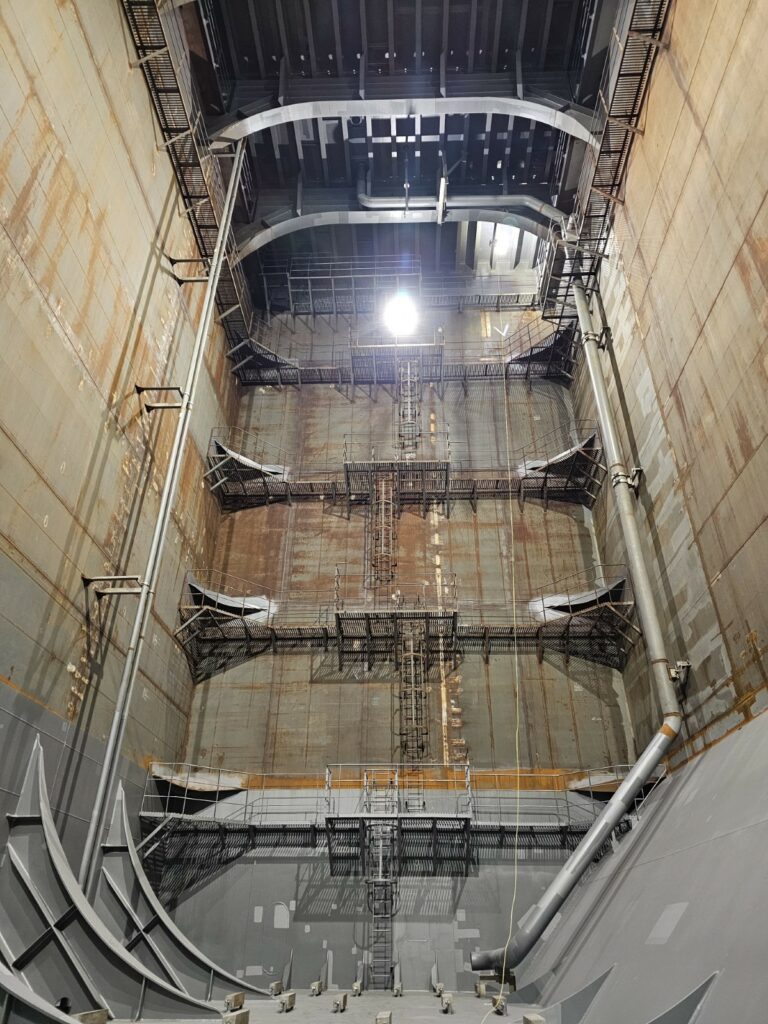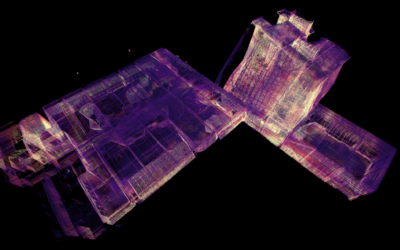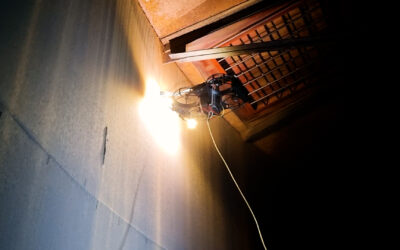Giant cargo tank remote inspection turns stress-free, safe and efficient with Unlimited Flight Time.
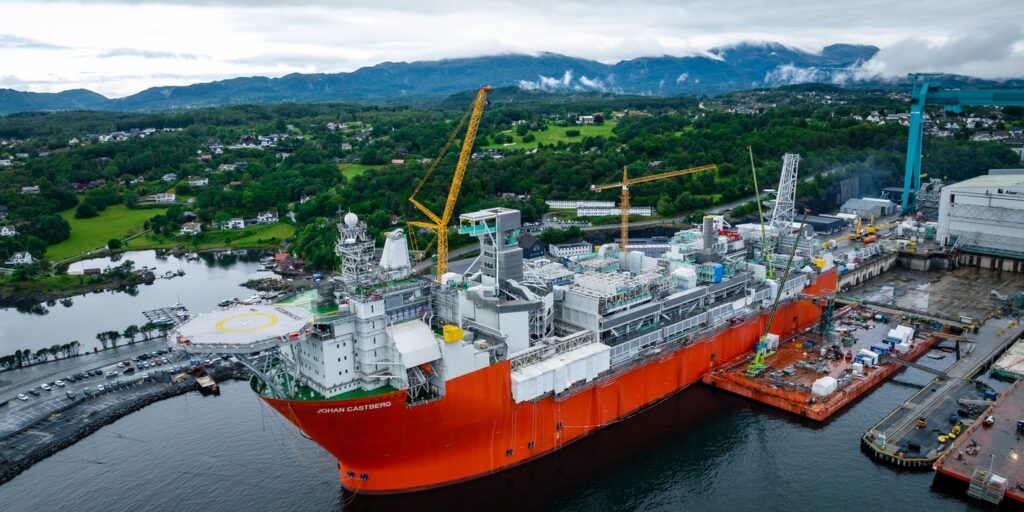
Summary
Equinor’s Johan Castberg FPSO is a large state-of-the-art offshore production, storage and offloading unit destined to operate under harsh arctic conditions in the Barents Sea for the next 30 years.
IKM Testing conducted inspection of the newly built vessel using the Scout 137 Drone System from ScoutDI. The scope was to document the coating condition and as-built structure welded to the underside of the cargo tank deck.
Parts of the job were done during cold winter days in a yard at Stord, Norway. Two inspectors covered vast area working on shifts, safely and comfortably seated on the tank floor.
Proper inspection of a huge commission project like Johan Castberg requires several revisits and many inspection hours. This inspection job relied on the Scout 137 Drone System’s unlimited flight time for safe execution and timely completion.
About IKM Testing AS
IKM Testing is a complete service provider to the energy industry. Since 1992, they have offered their services to both offshore and onshore sectors, establishing themselves as a significant supplier to the industry.
With headquarters in Sola, Norway, IKM Testing also has offices in Bergen, Kristiansund and Hammerfest. Additionally, they operate internationally, with offices in Asia, Australia, Brazil, Canada, Poland and UK, among others. IKM Testing AS is part of the IKM Group.
Stein Hanssen is one of the most experienced inspection pilots in Norway and was the chief pilot in charge of the Johan Castberg job.

Johan Castberg
Johan Castberg FPSO is a large offshore production, storage and offloading unit designed and destined to operate at the Johan Castberg field in the Barents Sea. Its approximate length and width are 313m (about the height of the Empire State Building) and 55 m (about the height of the Leaning Tower of Pisa).
Hull and living quarters were built in Singapore, while topside modules were constructed in Norway and installed at Stord where the FPSO was completed before heading to the field in the Barents Sea.
With a production capacity of nearly 220,000 barrels per day and 30 subsea wells tied back to the FPSO, Johan Castberg is projected to make significant contributions to the Norwegian Oil Fund over the next 30 years.

Job scope
The scope of this job was to establish baseline documentation of coating condition and the as-built structure welded to the underside of the cargo tank deck. The cargo tank deck area is about 3500 m2, and responsible and meticulous inspection is vital.
Coating protection is typically applied near the top and bottom inside cargo tanks and is of special importance. Structure welded to the tank deck underside that is not easily visible from the built-in inspection platforms, are also important POIs.
Because with a drone, you can reach mostly everything.
Objects may be discovered that could be potential falling objects, or that can harm the integrity of tanks and pumps. They must be located and removed before going to production. All such anomalies are addressed immediately.
Data from this inspection forms a part of the baseline documentation for subsequent Risk-Based-Inspection (RBI) , i.e. serves as comparison for future inspections. It allows likelihood estimation of future anomaly detections based on structural fatigue analysis in the design.
Meaning: That you can predict the likelihood of future issues.
Inspection of a huge project like Johan Castberg is meticulous work. Several revisits and many inspection/flight hours are necessary. It is vital that the crew remains safe and alert throughout long inspection hours, which may take place in freezing temperatures during cold Norwegian winter days.

Tethered drone system
The Scout 137 Drone System is a tethered system, meaning that the drone is connected to its Ground Station via a thin and lightweight cable (tether). Current standard tether length is 40 m.

The tether provides power and a fully wired control- and data connection. As long as the Ground Station is connected to a power source, the drone will remain powered and can stay in the air for as long as it needs.
The most important factor with such solutions is that there’s no longer a limitation on how long you can fly. The Scout 137 Drone doesn’t carry a battery with it in the air, but is connected via the Ground Station to a continuous power source – or a Portable Power Station. For practical purposes, we refer to it as “unlimited flight time”.
Inspection jobs can then be planned according to other criteria than battery capacity, for example data organization preferences. Extra equipment and stress related to frequent changes and charging of on-board batteries is eliminated, and the crew can concentrate on acquiring good data in a safe manner.
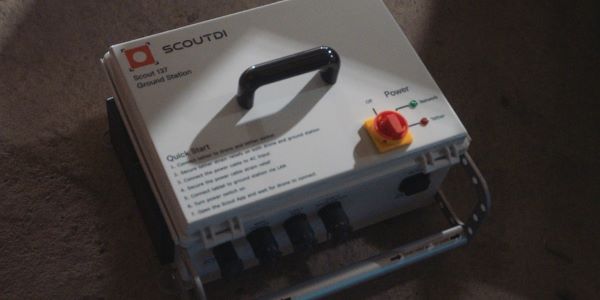
The pilot’s drone control station, consisting of a rugged tablet and a handheld controller, is also wired to the Ground Station. Our fully wired setup is therefore not subject to radio-frequency disturbance.
The Ground Station can be connected to the internet for live inspection streaming, via ethernet or your mobile phone’s 4G/5G.
Unlimited Flight Time: A Key Advantage
The drone inspection was conducted mainly from the cargo tank floor of Johan Castberg, keeping the crew safe and comfortable throughout the job.
Given the standard tether length of 40 m and the cargo tanks being +25 m tall, moving around the Ground Station now and then is required to reach everything comfortably. Sometimes, a tank may have structural details that make it desirable to fly with the tether hanging straight down, in which case the Ground Station must be moved more frequently.
Of course, moving the Ground Station does not mean you have to land the drone. It’s just about getting out of the chair, reposition the Ground Station (and the chair), while the Scout 137 hovers in the same place waiting for you to continue.
Each cargo tank represented approximately 120-150 minutes of flight-time. The cargo tanks were rather cold, with temperatures way below 0°C. For this reason, two pilots worked on shift, inspecting continuously for about one hour before shifting.
The tether of the Scout 137 Drone System enabled inspection of hard-to-reach structural components without the concern of pausing for battery changes before taking on the next challenge.
It also eliminates the need for improvising charging stations and a charging regime for many batteries, with chargers and sufficient power sources on the tank floor.
The ability to focus entirely on the job with minimal external distractions ensured the safety and efficiency of the operation.

Safety Benefits
Climbing remains the standard alternative method for structural inspections in the Oil & Gas and offshore industry. For this project, the shipyard would not have built scaffolding for accessing the structure, as that could damage the fresh coating.
In any case, due to the significant height and size of the Johan Castberg tanks, climbing or working from scaffolding is inherently risky, labor-intensive, and time-consuming.
The reduction of human exposure to hazardous tank environments is key. By utilizing the unlimited flight time property, the pilots remained safe and relaxed on the cargo tank floor, concentrating solely on the drone’s navigation and inspection without the additional physical strain and dangers of climbing.
This approach, relying on the Scout 137 Drone System’s unlimited flight time and BVLOS capabilities, resulted in a much more safe, efficient and accurate inspection process, as they did not need to move around at height.

Operational Benefits and Efficiency
The vast scale of the FPSO and meticulous nature of this inspection, plus the needs to minimize interference with yard schedules also required a highly efficient inspection process. The unlimited flight time enabled Hanssen and his colleague to conduct a thorough examination without unnecessary interruptions.
The Scout 137 Drone’s ability to cover large areas seamlessly made the inspection efficient. It allows organizing the inspection in a way practical for both data structure and job completion concerns. You can inspect starboard transversals, deck and aft in separate sessions, whichever way makes most sense out of on-site considerations or to the data assessment work in the Scout Portal afterwards.

The IKM pilots generally flew at approximately 80 cm surface distance throughout the job, for good coverage while also balancing glare intensity from the protruding H-beams. Their experience is that the drone’s intuitive controls and anti-collision system are helpful tools when navigating complex tank environments.
The system’s virtual anti-collision bubble ensures that the drone remains at safe distance from any obstacles, while the visual spatial awareness provided adds new meaning to the concept of “arm’s length”, feeling like an extension of your own arm (holding the camera).
These features combined mean that every aspect of the cargo tanks can be inspected effectively and without concerns about damaging equipment or breaking time schedules.

Conclusion
The inspection of the Johan Castberg cargo tanks showcases how the Scout 137 Drone System’s unlimited flight time and advanced positioning features simplify complex inspections inside large structures.
Several inspection revisits were necessary to complete the job, and it was vital to maximize efficiency while maintaining the safety and comfort of the inspection crew. Minimizing external distractions is necessary to achieve max job focus and efficiency.
The Scout 137 Drone System allowed the team from IKM Testing to complete the job efficiently from a seated position on the tank floor with a safety distance to the flight zone, working on shift for 22 inspection/flight hours in total.
The tethered design of the Scout 137 Drone System provided valuable flexibility for organizing the job while eliminating the stress of limited flight time and battery management related to non-tethered solutions. In volumes like this, the Ground Station must be moved around a few times for full coverage. But this is 100% under the inspector’s control and puts no pressure on the crew.
Stein Hanssen of IKM Testing praises ScoutDI as a forward-thinking company, providing unparalleled support and valuable technology to address the rigorous requirements of challenging offshore projects.
